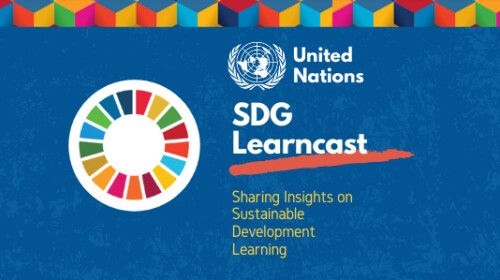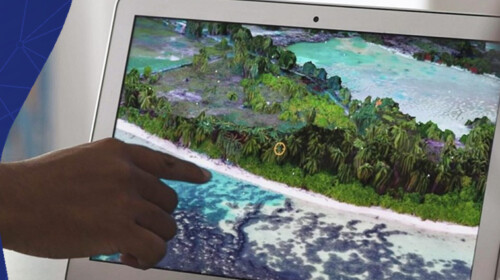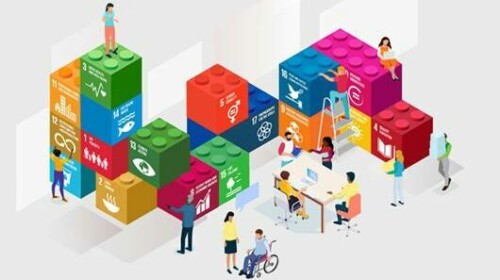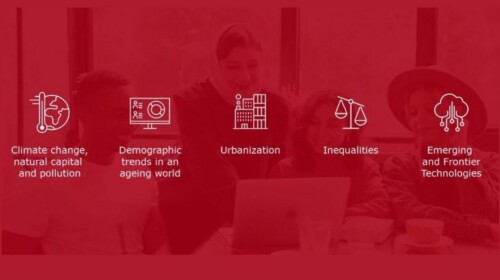In this episode of the SDG Learncast, we feature Breanne Pitt, a researcher and educator, on the concept of systems thinking and its vital role in modern education. They explore the challenges and complexities of the digital age, discuss the impact of standardized testing, and delve into practical tools like the World Economic Forum's Transformation Maps. This enlightening conversation underscores the importance of a proactive approach to teaching, preparing students for a deeply interconnected world.
You can read more about Breanne Pitt's White Paper on Innovative Learning Solutions to Navigate Complexity: Adapting Systems Thinking to Future Classrooms.
[What follows is a transcription of the podcast, modified for enhanced web readability.]
Paulyn Duman: Welcome to the SDG Learncast with me, Paulyn Duman. In every episode, I bring insightful conversations around the subject of sustainable development and learning, helping us all to achieve a sustainable future.
In this episode, we are joined by Brianne Pitt, an educator and scholar who brings together different aspects of education, media, and technology. She's currently pursuing her PhD at Trinity College, Dublin focusing on digital narrative architectures and systems thinking.
Brianne worked as a research fellow at the World Economic Forum, strategic intelligence platform, where she explored the application of systems thinking tools and education.
Can you tell us what systems thinking is in simple terms?
Breanne Pitt:
Hi Paulyn, thank you so much for having me. Yeah, so systems thinking is actually not quite as complex as people think it is. Some people think it's a bit more of something very abstract and theoretical, but it isn't. So to put it in real basic terms, systems thinking is like putting together a big puzzle.
When you look at just one piece of the puzzle, you don't really get to see the whole picture. So instead of just looking at one piece of that puzzle, systems thinking helps us see how all the different pieces fit together to create a whole.
It's like putting on some special glasses, which help you see how different things are connected and how they work together. A really popular analogy on systems thinking is that of the iceberg. So when you look at an iceberg from a ship, you only see a small portion visible from the water or above the water.
And the majority of that iceberg, though, is hidden below the surface. So systems thinking helps us uncover those underlying structures and dynamics that shape that iceberg and basically enable us to explore the different deeper layers which represent the complex factors and forces that influence what we see on that surface.
And in a sense, you can think of it as helping us to prevent a collision with the submerged section of that iceberg and sinking a ship. So ultimately, when people are able to see a system as a whole, they can better criticize, analyze the system, and even develop resiliency, empathy, adaptability, and a lot of other skills that are super important, especially for us to be teaching young people today.
Paulyn Duman: How does the current educational system, particularly standardized testing impact the development and retention of systems thinking and students? And are there any effective ways or examples of incorporating systems thinking from an early age?
Breanne Pitt: I recently listened to a podcast that was based on Derek and Laura Cabrera's research Lab. So they have the Cornell Cabrera Research Lab, which they're a global leader in systems thinking, and they believe that actually, we are all born systems thinkers, but at around third grade, we're trained out of it as institutions overemphasize test-taking and standardized learning, resulting in schools that ultimately prioritize transmitting test answers and don't really encourage the love of learning and fostering our innate systems thinking abilities.
So these standardized tests, they involve things like multiple-choice questions, which discourage exploration and curiosity, but instead, they prepare students to regurgitate the right answer instead of exploring and being curious about all of the potential answers that can be out there. So in a sense, standardized tests prepare students to pick a side and then move on rather than encouraging exploration, reflection, and lifelong learning, love of learning, etc. And furthermore, these tests, saying that the testing requirements result in teachers having a lot of curriculum restraints.
And these curriculum restraints can limit time and flexibility to be able to incorporate things like systems thinking into the curriculum because they really feel pressured to cover a wide range of content in a fixed timeframe. And this doesn't really leave any room for systemic perspectives.
Derek and Laura Cabrera described, for example, how they use a simple song about "Parts and Wholes” to teach five-year-olds the basics and systems thinking. And it was just a little sing-along song that said, every part has a whole, in every whole it can be broken down into parts. So it was a very simple song that the five-year-olds could understand it. And one day, this teacher took her kids, these five-year-olds that were taught the song, she took her kids to an apple orchard. And without any prompting, the students started noticing all sorts of different things about the apples.
For example, one of the students came up to the teacher and says, "Hey, look at the bottom of this apple. What is this fuzzy part called? I think I just discovered a totally new element of the apple. I want to call it the apple's belly button." And the teacher goes, "I don't actually know what this is called."
So she reached out to the Cabrera Institute and told them about the experience with the students. The bunch of the students were discovering all these different things about the apple, and they think discovered a new element to the apple, and they wanted to know if it had a name or if they could name it the “belly button”.
Paulyn Duman: Have you utilized modern tools or platforms in your educational approach to help students understand global challenges and interconnected systems?
Breanne Pitt: So something specifically, I've done a lot of work with the World Economic Forum's Strategic Intelligence Platform's transformation maps. These transformation maps are basically a data visualization tool that can help make invisible systems more visible.
They're a visual representation of global challenges that the world faces, and they highlight key trends, different technologies, and shifts in this global landscape. And visually, if you just picture a web, with a center and two surrounding rings. The center includes a node, which is the main topic, and there are 294 topics in the database to explore.
So the inner circle surrounding the main topic consists of different nodes that represent the key issues related to that topic. And then the outer ring outside consists of other nodes that represent related topics to the key issues.
I'm trying to meet the students where they are, and they're a digital generation, so I love to use technology in my classrooms and make them interested. And I find that all the students that I have worked with using the map, they really like them and have a lot of positive feedback.
Paulyn Duman: Can you share some practical examples or case studies of how you have integrated the World Economic Forum, transformation maps into educational settings? How have these tools been received by both educators and students and what impact have they had on their understanding and learning process?
Breanne Pitt: I reached out to educational institutions that were already using the maps, and then I also spoke to some innovative teachers that were willing to develop lessons to test out the maps in the classroom. I worked with Lasma Skestere. She's a lecturer there and she's also the Latvian head of communication of the communication division at the Ministry of Education and Science, and she was teaching a master's level class called New Media and Net Society.
So in this class, we focused on exploring Latvian political parties using digital tools like the Create Map tool from the Transformation Maps. I provided students with technical instructions on how to use the forum's advanced features like the Create Map tool and the monitor tools.
And the students were tasked with mapping a political party that was being represented in the upcoming senatorial election. So this was actually a real-time thing that was happening in Latvia at the time. And the students, they identified a specific political party that they wanted to focus on, and then they defined the key platforms, policies, and issues of those platforms.
And then from there, they were able to identify different categories like economy, healthcare, education, environment for policy, etc. They created these maps to really showcase how all of these things were connected, and not just within Latvia, but also how they connected to the rest of the world. It made students aware of party misconceptions. They made students aware of the connections to other global systems, and then they also made students aware of potential impacts these parties can make on both the global and local systems.
So ultimately, having the students work with the maps helped them visualize how complex a political party and its platform really is, but it helped them also understand what political parties they might share their own personal values and which ones they might belong to.
Another one, my favorite example from the use cases that I explored was that of Dr. Wendy Youngblood's US High School class at Shepaug Valley High School in Connecticut. I loved this lesson because it's a really concrete example of how any teacher who teaches writing, which honestly should be all teachers. It's a concrete example of how they can really seamlessly integrate a systems thinking tool into their lesson plans.
She was basically conducting a lesson on Puerto Rico and its complex political status. And what we did is we used the Create Map tool to help students craft argumentative essays. So essay mapping is something that's a very common practice in education, and teachers use all different types of tools, both digital and traditional, to help students visually map their arguments and map their essays.
So we use the Transformation Maps from the World Economic Forum to map their essays. Systems methodologies lend themselves really beautifully to developing arguments because they encourage us to look at an issue in its entirety, not just through your own personal stance. And in order to develop a really good argument, you need to recognize counterarguments and be able to refute them.
So what the maps did is they helped the students visualize their argument by looking at all of these interconnected parts that they need to address if they're going to have an educated stance on the topic. And one of the things that Dr. Youngblood said she did really like about the Forum's Transformation Map tool was that she was confident that the students were accessing reliable sources that were curated by some of the world institutions and all of their related publications. So she felt very safe letting the students explore this openly. Get kids really curious, get them excited, and they just never stop learning. They'll keep on exploring.
Paulyn Duman: So what would you say to education stakeholders who might be skeptical about using systems thinking and education, and how can teachers be prepared or trained to effectively use systems thinking methodologies in their classrooms?
Breanne Pitt: I was a teacher for 10 years, and I'm very familiar with something that I like to call initiative fatigue. Teachers often experience initiative fatigue, and this is something that they encounter, which is a result of the constant influx of new frameworks, new methodologies, and new initiatives in education. The fatigue basically arises from an overwhelming pressure to adopt new approaches while simultaneously managing their existing responsibilities: their classrooms, grading, etc. So what teachers don't realize is that incorporating systems thinking may involve some adjustments to instructional strategies and tools; it ultimately just leverages their existing training, their existing pedagogical knowledge, and their existing expertise.
Systems theory acts as an umbrella that ultimately integrates and builds upon existing knowledge and practices of classroom teachers: things like constructivism, child-centered learning, Vygotsky's zone of proximal development, and these are just to name a few of the things that teachers learn.
These systems already exist, but they're just invisible to us, and teachers can use some of the learning frameworks and methodologies that they've already been trained with to help make these systems more visible to students.
So once students can further develop these innate system thinking skills, they can carry them in their little backpacks to all of their classes, their future work, and their future lives. Where I do see the kickback is that education reform is largely reactive and it's not proactive. Society rewards reactiveness, this instant satisfaction and real quick fixes, rather than fixing root causes because those take a lot longer and they're much more complicated.
Throughout history, education has evolved as a result of global events and things that are happening currently. So for example, if there's a sudden surge in demand for a certain type of worker with a certain type of skill, educational systems react to that by introducing new programs or new curriculums that meet that demand.
And while there is value in reacting to societal needs, a more productive method of reform would be to be proactive and anticipate them. Use systems thinking in your classrooms because you already have the skills to teach systems thinking.
Paulyn Duman: And that was Breanne Pitt of the Trinity College and the World Economic Forum.
What are my key takeaways from this episode?
First is that systems thinking provides a comprehensive view of the world, enabling critical analysis and fostering skills adaptability, and empathy.
Second, current challenges in education stem from an over-reliance on standardized testing, a complex media landscape, and the rapid changes brought about by digital technology.
I also learned that innovative tools like the World Economic Forums' Transformation Maps can make invisible systems more visible and enhance the learning experience.
And lastly, I learned that to bring about meaningful change in education, there's a need to be proactive, integrating systems thinking into teaching practices, and anticipating future challenges.
You can find more of the SDG Learncast on the UN SDG:Learn website. For now, I’m Paulyn Duman. Thanks for listening.





